 Volume 26, No.
4 – April 2013 Volume 26, No.
4 – April 2013
Volume 26, No. 4
Editor: Stephen L. Seftenberg
Website:
www.CivilWarRoundTablePalmBeach.org
April 10, 2013 Assembly
Donna Gruber Adair is a former high school teacher of English and
creative writing with a degree in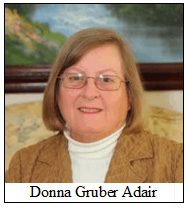 history. She is the author of award-winning short fiction and poetry.
Her interests include historical research and genealogy, with an
emphasis on 19th century American history. Her novel, "An American
Odyssey," is "A captivating generational tale of one family's pioneering
travels during America's 19th-century westward expansion. Adair
masterfully weaves pivotal events of the 1800s such as slavery, Bleeding
Kansas, the Pike's Peak gold rush and the bloody carnage on the
battlefields of Shiloh, Bull Run and Gettysburg into the lives of this
family, crafting a perfect mix of action, tragedy, and romance. It is a
fitting, rousing tribute to the courage of ordinary families who made
extraordinary sacrifices." Ms Adair’s talk is entitled "A Pioneer Family
Faces the Civil War." Be sure to come!
history. She is the author of award-winning short fiction and poetry.
Her interests include historical research and genealogy, with an
emphasis on 19th century American history. Her novel, "An American
Odyssey," is "A captivating generational tale of one family's pioneering
travels during America's 19th-century westward expansion. Adair
masterfully weaves pivotal events of the 1800s such as slavery, Bleeding
Kansas, the Pike's Peak gold rush and the bloody carnage on the
battlefields of Shiloh, Bull Run and Gettysburg into the lives of this
family, crafting a perfect mix of action, tragedy, and romance. It is a
fitting, rousing tribute to the courage of ordinary families who made
extraordinary sacrifices." Ms Adair’s talk is entitled "A Pioneer Family
Faces the Civil War." Be sure to come!
March 13, 2013 Assembly
Christian Davenport, the official archaeologist for Palm Beach
County, entertained the Assembly by shining his spotlight on the
American soldiers and sailors who survived the Second Seminole War
(1835-1842) to play a leading role in the Civil War. This was the
fiercest war waged by the U.S. government against American Indians. The
United States spent more than $20 million fighting the Seminoles. The
war left more than 1,500 soldiers and uncounted American civilians dead.
And the obvious duplicity of the U.S. government's tactics marred
Indian-white relations throughout the country for future generations.
The Micos Jumper, Alligator, Micanopy and Osceola, leading less
than 3,000 warriors, held their own against four U.S. generals and more
than 30,000 troops, employing guerrilla tactics that cost the Americans
dearly. In 1842, a nominal end to the hostilities arrived, though no
peace treaty was ever signed. By this time most Seminoles had been
moved from Florida, relocated to Indian Territory (today’s Oklahoma).
The first battle of the Loxahatchee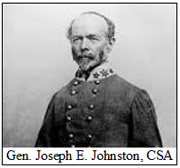 River took place on January
River took place on January
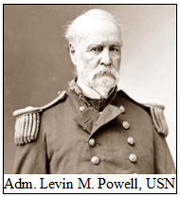 15th,1838.
Lieutenant Levin M. Powell (4/21/03 - 1/15/85) led the U. S. Navy
Waterborne Everglades Expeditionary Unit composed of 75 inexperienced
Army and Naval men, and was soundly defeated by 50-60 Seminole warriors,
losing four dead and 21 wounded. The hero of this engagement was Joseph
E. Johnston (2/3/07-3/21/91) who took charge, directed a rear guard
action and prevented what might well have become "Powell’s Massacre." He
later counted 30 bullet holes in his uniform! Powell, credited with
inventing "riverine" warfare doctrines still used today, performed
creditably in the subsequent clashes. Johnston became a noted
Confederate general in the Civil War and in a chivalric gesture, was a
pallbearer at Gen. Sherman’s funeral. 15th,1838.
Lieutenant Levin M. Powell (4/21/03 - 1/15/85) led the U. S. Navy
Waterborne Everglades Expeditionary Unit composed of 75 inexperienced
Army and Naval men, and was soundly defeated by 50-60 Seminole warriors,
losing four dead and 21 wounded. The hero of this engagement was Joseph
E. Johnston (2/3/07-3/21/91) who took charge, directed a rear guard
action and prevented what might well have become "Powell’s Massacre." He
later counted 30 bullet holes in his uniform! Powell, credited with
inventing "riverine" warfare doctrines still used today, performed
creditably in the subsequent clashes. Johnston became a noted
Confederate general in the Civil War and in a chivalric gesture, was a
pallbearer at Gen. Sherman’s funeral.
Nine days later, Major General Thomas Jesup, furious with Powell’s
botched effort, led 1,600 troops against 100 to 300 Seminoles. His
"army" consisted of 400 regular dragoons, 600 dismounted cavalry, 500
Tennessee volunteers and 100 Alabama volunteers). The Army fared better
in this battle, having both cavalry and artillery, including Congreve
rockets (which did little damage but did scare both the Seminoles and
their horses!)
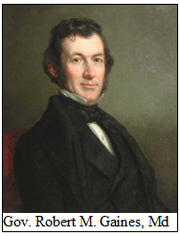 Although
little known, these battles ended the organized resistance of the
Seminoles during the Second Seminole War. After the second battle,
Jesup’s troops built Fort Jupiter on a point of land in the Loxahatchee
River now called Pennock Point, about three miles west of the Jupiter
Inlet. The trail his men blazed is today’s Military Trail. Although
little known, these battles ended the organized resistance of the
Seminoles during the Second Seminole War. After the second battle,
Jesup’s troops built Fort Jupiter on a point of land in the Loxahatchee
River now called Pennock Point, about three miles west of the Jupiter
Inlet. The trail his men blazed is today’s Military Trail.
Other participants in this war who became better known in and after
the Civil War included, Robert Milligan Gaines (6/25/15 - 4/16/98), a
second lieutenant of Artillery at the Battle of Loxahatchee, worked
successfully to prevent Maryland from seceding in 1860-61. He later was
Governor of Maryland and Ambassador to France.
Winfield Scott (6/13/1786-5/27/66), commanded the U. S. forces in the
Second Seminole War, but in 1836, he was recalled to Washington due to
the dubious tactics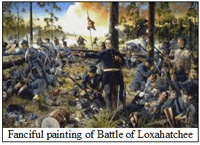 against the Indians and huge expenses of policing the frontier,
compounded by controversies between regular army and local militia
officers. Old "Fuss and Feathers" went on to fame in the Mexican War,
lost the 1852 presidential election, served as Commanding General of the
U. S. Army for 20 years, and thought up the "Anaconda Plan" to strangle
the Confederacy in the Civil War.
against the Indians and huge expenses of policing the frontier,
compounded by controversies between regular army and local militia
officers. Old "Fuss and Feathers" went on to fame in the Mexican War,
lost the 1852 presidential election, served as Commanding General of the
U. S. Army for 20 years, and thought up the "Anaconda Plan" to strangle
the Confederacy in the Civil War.
John Bankhead Magruder (5/1/07-2/19/71) served in this battle, but
went on to earn the nickname of "Prince John" as a Confederate general,
has the unique distinction of being a general in three different armies:
the U. S. Army, the Confederate Army and finally the Imperial Mexican
Army!
 Robert
Anderson (6/14/05 - 10/26/71) served in the Second Seminole War as an
assistant adjutant general on the staff of Gen. Winfield Scott. When
South Carolina seceded In December 1860, Major Anderson, a pro-slavery,
former slave-owner from Kentucky, remained loyal to the Union. Acting
without orders, he moved his small garrison from indefensible Fort
Moultrie to the more defensible Fort Sumter in the middle of Charleston
Harbor. Ordered by President Jefferson Davis to capture the fort, Brig.
Gen. P. G. T. Beauregard, who had been Anderson's student at West Point,
attacked April 12, 1861. Anderson, badly outnumbered and outgunned,
surrendered on April 14. Thus began the Civil War! Robert
Anderson (6/14/05 - 10/26/71) served in the Second Seminole War as an
assistant adjutant general on the staff of Gen. Winfield Scott. When
South Carolina seceded In December 1860, Major Anderson, a pro-slavery,
former slave-owner from Kentucky, remained loyal to the Union. Acting
without orders, he moved his small garrison from indefensible Fort
Moultrie to the more defensible Fort Sumter in the middle of Charleston
Harbor. Ordered by President Jefferson Davis to capture the fort, Brig.
Gen. P. G. T. Beauregard, who had been Anderson's student at West Point,
attacked April 12, 1861. Anderson, badly outnumbered and outgunned,
surrendered on April 14. Thus began the Civil War!
John Clifford Pemberton (8/10/14 - 7/13/81) was a 2nd Lt. in the 4th
U. S. Artillery. He went on to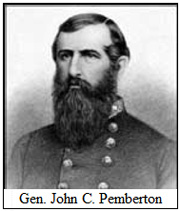 serve as the Confederate general who surrendered Vicksburg July 4, 1863.
Braxton Bragg would not take him on his staff, so Pemberton accepted
appointment as a Lt. Col. in the Artillery and continued to fight for
the Confederacy. In July 1864, Confederate cavalry under his command
"levied" $200,000 each from Frederick and Hagerstown, Maryland to avoid
being sacked!
serve as the Confederate general who surrendered Vicksburg July 4, 1863.
Braxton Bragg would not take him on his staff, so Pemberton accepted
appointment as a Lt. Col. in the Artillery and continued to fight for
the Confederacy. In July 1864, Confederate cavalry under his command
"levied" $200,000 each from Frederick and Hagerstown, Maryland to avoid
being sacked!
Braxton Bragg (3/22/17 - 9/27/76) served as a 2d Lt. in the 3rd U. S.
Artillery at the second battle. His specialty was the Napoleon
howitzers. He went on to serve as a Confederate general who won the
Battle of Chickamauga, but lost his command because he could not get
along with his officers.
Christopher Carlist Tompkins (8/4/13 - 5/28/77) served as a 2d Lt. in
the 3rd U. S. Artillery in this battle and in skirmishes near Ft.
Lauderdale, Feb. 20 and Sep. 27, 1838. He served as a Colonel of West
Virginia Militia, but left the Confederate service in 1862, to operate a
coal mine near Richmond, Virginia.
Jubal Early (11/3/16 - 3/2/94) served as a 2nd Lt. in the 3rd U. S.
Artillery. He went on to acclaim in the Civil War, although his bad
temper caused Gen. Lee to remove him from command in the Shenandoah
Valley in 1864. After the war, he fled to Mexico, Cuba and Canada,
returned to the U. S. to be pardoned by President Johnson, led a
vituperative campaign against Gen. Longstreet and was a leading promoter
of the "Lost Cause."
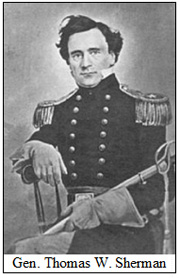 Thomas
W. Sherman (3/26/13 - 12/31/79), served as a 2d Lt. in the 3rd U. S.
Artillery. He served for the Union with distinction during the Civil
War, losing his right leg at the Port Hudson, Louisiana. Thomas
W. Sherman (3/26/13 - 12/31/79), served as a 2d Lt. in the 3rd U. S.
Artillery. He served for the Union with distinction during the Civil
War, losing his right leg at the Port Hudson, Louisiana.
Seth Thornton (1814-1846) was a 2d Lt. in the Dragoons, and
technically doesn’t belong to this list, because he died in the Mexican
War. However, he is worth remembering, since he is credited with
starting the Mexican War on April 25, 1846, when he led a squadron into
the town of Santa Rosa, where his group was soundly defeated and
captured by the Mexicans. Thornton was wounded at Santa Rosa and was
killed in a later battle.
Davenport then paired two dragoons, William S. Haney, who became a
Union general, was captured and then released by the Confederates and
retired, and Thomas T. Fauntleroy, who was commissioned in the
Confederate Army but resigned.
Lloyd J. Beall (10/19/18 - 11/10/87), was a dragoon in the Seminole
War, then served as a paymaster in the U. S. Army, then left to head up
the fledgling Confederate Marine Corps. By the end of the Civil War, his
men were recognized as good fighters on land and sea.
Benjamin L. Beall (1801-1863) (no relation) was Captain in the 2nd
Dragoons. Shortly afterward the U.S. 2nd Dragoon Regiment, was formed
and Beall led Company I. Capt. Beall was familiarly known as "Old Ben
Beall." Gen. Worth officially reported that Beall "has met the enemy in
this contest, oftener, perhaps, than any other officer." Beall fought on
the Western frontier and was put in command of the First Dragoons
Regiment (soon renamed as the First Regiment of Cavalry). Beall, then
commanded the Military District of Oregon, then led his troops by
steamship through Panama and then to Washington, D.C.
William Gilpin (10/14/13 - 1/20/94), served in the Second Seminole
War right out of West Point,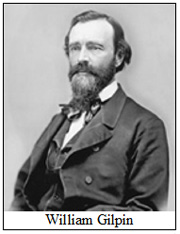 as a 2d Lt. in the Dragoons. After the war, he joined Fremont’s
expeditions and moved to the Oregon Territory. He led the fight for
Oregon’s statehood, fought in the Mexican War, and was named the first
Governor of the Colorado Territory. He got in trouble raising funds to
recruit the 1st Colorado Volunteers, derisively called "Gilpin’s Pet
Lambs." The mustering and training of the regiment proved to be highly
useful when the Confederates launched an invasion northward through the
New Mexico Territory in the spring of 1862, intending to seize the
mineral-rich Colorado Territory and eventually California. The volunteer
regiment raised by Gilpin's efforts played a critical role in the
campaign, routing the Texans at the Battle of Glorieta Pass, which
became known as the "Gettysburg of the West".
as a 2d Lt. in the Dragoons. After the war, he joined Fremont’s
expeditions and moved to the Oregon Territory. He led the fight for
Oregon’s statehood, fought in the Mexican War, and was named the first
Governor of the Colorado Territory. He got in trouble raising funds to
recruit the 1st Colorado Volunteers, derisively called "Gilpin’s Pet
Lambs." The mustering and training of the regiment proved to be highly
useful when the Confederates launched an invasion northward through the
New Mexico Territory in the spring of 1862, intending to seize the
mineral-rich Colorado Territory and eventually California. The volunteer
regiment raised by Gilpin's efforts played a critical role in the
campaign, routing the Texans at the Battle of Glorieta Pass, which
became known as the "Gettysburg of the West".
Other men who were involved in the Second Seminole War and who later
served in the Civil War included Samuel H. Anderson (CSA), George H. A.
Blake (USA) was a 1st Lt. in 1838 and a full Col. in command of the 2d
Brigade of Cavalry in 1862. He fought bravely at the Battle of Gaines
Mills and was assigned to "special duty" (spying?) thereafter.
Christian Davenport "christened" our new meeting place in fine style
and was rewarded with sustained applause. We look forward to future
assemblies in this bright, clean and spacious space!
Last changed: 04/03/13
Home
About News
Newsletters
Calendar
Memories
Links Join
|

